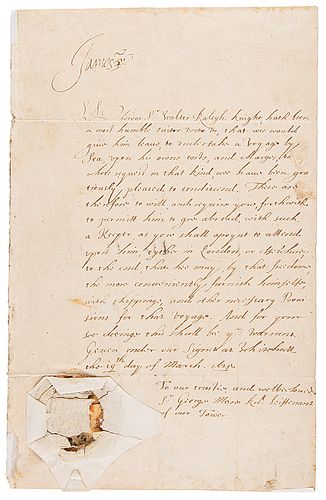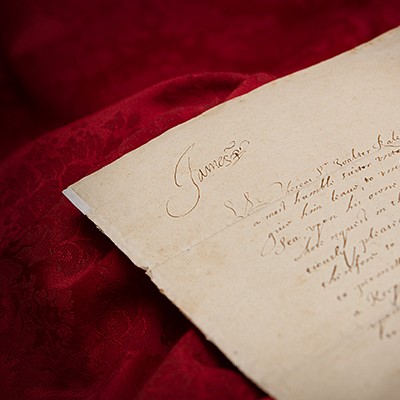King James VI Discharges Walter Raleigh from Tower of London
Two ways to bid:
- Leave a max absentee bid and the platform will bid on your behalf up to your maximum bid during the live auction.
- Bid live during the auction and your bids will be submitted real-time to the auctioneer.
Bid Increments
| Price | Bid Increment |
|---|---|
| $0 | $5 |
| $50 | $10 |
| $200 | $25 |
| $500 | $50 |
About Auction
Mar 8, 2023
RR Auction support@rrauction.com
- Lot Description
Historic DS, signed “James R,” one page, 7.5 x 12, March 19, 1615. The King's warrant addressed to Sir George More for the discharge of Sir Walter Raleigh from imprisonment in the Tower of London, thereby allowing him to prepare for his last voyage to the Americas. In part: "Whereas Sir Walter Ralegh knight hath been a most humble suitor unto us, that wee would give him leave to take a voyage by Sea, upon his own costs and charges, to whose request in that kind wee have been graciously pleased to condescend, These are therefore to will and require you forthwith to permitt him to goe abroad with such a Keeper as you shall apoynt to attend upon him either in London or elsewhere to the end that he may by that freedome the more conveniently furnish himself with shippinge and other necessary provisions for that voyage." Signed at the head in ink by King James VI. The original white paper seal affixed to the lower left corner remains partially intact. In very good to fine condition, with scattered faint staining, and some damage to the wax-and-paper seal.
Sir Walter Raleigh was first imprisoned in the Tower of London in 1591, after his illicit secret marriage to one of Queen Elizabeth I's ladies-in-waiting, Elizabeth (‘Bess’) Throckmorton, was found out. He was released after a few months, but banished from the royal court for five years. In the meantime, Raleigh heard of a 'City of Gold' in South America and sailed to find it in 1594. On his return to England, he published an exaggerated account of his experiences in Guiana in a book that contributed to the legend of El Dorado. Though he had managed to restore royal favor with Queen Elizabeth, she passed away in 1603 and he became embroiled in a plot to overthrow her successor, King James I. Arrested, tried, and convicted of treason, Raleigh was again sent to the Tower for what he expected would be life imprisonment.
During his extended confinement, Raleigh hatched a scheme that would appeal to the king's avarice and grant him freedom: a plan for another expedition to the Orinoco in Guiana, where he was convinced that he had ascertained the existence of a gold mine. He would finance the voyage himself, and provide King James with one-fifth of the profits. James assented to the plot, and signed the present warrant to allow Raleigh the freedom to begin his preparations for the expedition. He would soon commission the building of the Destiny—a 500-ton treasure-hunting ship bound of El Dorado.
Conceived with the highest and most enthusiastic hopes, the expedition set sail in June 1617 and ended disastrously: Raleigh himself was too ill to lead his force when they landed, and a detachment of men under his command attacked a Spanish outpost on the Orinoco river, violating existing peace treaties and Raleigh's own orders. His son was shot and killed in the skirmish, and—to make matters worse—they found no treasure. On his return to England, Raleigh was arrested and accused of fabricating reports of South American gold mines in order to plunder the Spaniards. Under pressure from Spain's ambassador, King James reinstated Raleigh's death sentence and returned him to the Tower of London. On October 29, 1618, he was beheaded outside the Palace of Westminster.
Past sales history: The Library of William Foyle, Christie's, July 12, 2000. - Shipping Info
-
Bidder is liable for shipping and handling and providing accurate information as to shipping or delivery locations and arranging for such. RR Auction is unable to combine purchases from other auctions or affiliates into one package for shipping purposes. Lots won will be shipped in a commercially reasonable time after payment in good funds for the merchandise and the shipping fees are received or credit extended, except when third-party shipment occurs. Bidder agrees that service and handling charges related to shipping items which are not pre-paid may be charged to a credit card on file with RR Auction. Successful international Bidders shall provide written shipping instructions, including specified Customs declarations, to RR Auction for any lots to be delivered outside of the United States. NOTE: Declaration value shall be the item’(s) hammer price and RR Auction shall use the correct harmonized code for the lot. Domestic Bidders on lots designated for third-party shipment must designate the common carrier, accept risk of loss, and prepay shipping costs.
-
- Buyer's Premium



 EUR
EUR CAD
CAD AUD
AUD GBP
GBP MXN
MXN HKD
HKD CNY
CNY MYR
MYR SEK
SEK SGD
SGD CHF
CHF THB
THB




